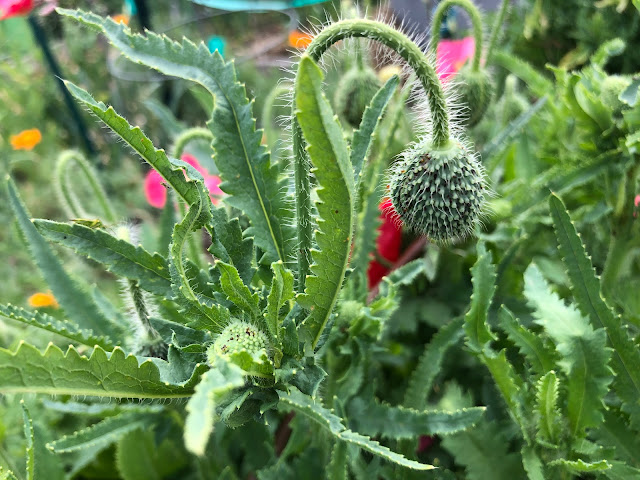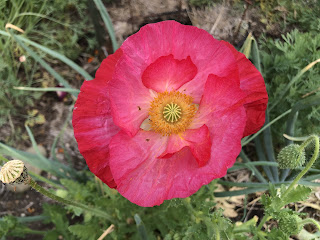
Clouds and chance of rain will keep weather cool

|
|
Shirley poppy buds look almost alien before they bloom. They are annuals but the flowers will reseed every year. See below for a poppy in bloom. (Photos: Kathy Morrison)
|
Just when it looked like we were plunging right into summer, Mother Nature throws us a curve – and the possibility of rain.
Showers are in the Northern California forecast Sunday through Tuesday, says the National Weather Service. Unfortunately, it looks like that rain will stay north of Sacramento. While we won’t get much (if any) precipitation, we will see plenty of clouds and cooler temperatures. The forecast calls for afternoons in the mid 60s to low 70s – well below normal. Our average high for early May: 80 degrees.
The fringes of this storm system also could create very windy conditions, particularly Sunday and Monday. Tie anything down that could blow away.
In the garden, make the most of cooler conditions – and get to work:
* Plant, plant, plant! It’s prime planting season in the Sacramento area. Time to set out those tomato transplants along with peppers and eggplants. Pinch off any flowers on new transplants to make them concentrate on establishing roots instead of setting premature fruit.
* Direct-seed melons, cucumbers, summer squash, corn, radishes, pumpkins and annual herbs such as basil.
* Harvest cabbage, lettuce, peas and green onions.
* In the flower garden, direct-seed sunflowers, cosmos, salvia, zinnias, marigolds, celosia and asters. Or transplant seedlings for many of the same flowers.
* Plant dahlia tubers. Other perennials to set out include verbena, coreopsis, coneflower and astilbe.
* Transplant petunias, marigolds and perennial flowers such as astilbe, columbine, coneflowers, coreopsis, dahlias, rudbeckia and verbena.
* Keep an eye out for slugs, snails, earwigs and aphids that want to dine on tender new growth.
* Feed summer flowering annuals and perennials with a balanced fertilizer.
* For continued bloom, cut off spent flowers on roses as well as other flowering shrubs.

|
|
Shirley poppies come in many shades of pink and
red, as well as white, purple, lavender and peach. |
* Put your veggie garden on a regular diet. Set up a monthly feeding program, and keep track on your calendar. Make sure to water your garden before applying any fertilizer to prevent “burning” your plants.
* Add mulch to the garden to help keep that precious water from evaporating. Mulch also cuts down on weeds. But don’t let it mound around the stems or trunks of trees or shrubs. Leave about a 6-inch to 1-foot circle to avoid crown rot or other problems.
Comments
0 comments have been posted.Sacramento Digs Gardening to your inbox.
Sites We Like
Garden Checklist for week of May 5
Survey your garden after the May 4 rainstorm. Heavy rain and gusty winds can break the neck of large flowers such as roses. Also:
* Keep an eye on new transplants or seedlings; they could take a pounding from the rain.
* Watch out for powdery mildew. Warmth following moist conditions can cause this fungal disease to “bloom,” too. If you see a leaf that looks like it’s dusted with powdered sugar, snip it off.
* After the storm, start setting out tomato transplants, but wait on the peppers and eggplants (they want warmer nights). Pinch off any flowers on new transplants to make them concentrate on establishing roots instead of setting premature fruit.
* Trim dead flowers but not leaves from spring-flowering bulbs such as daffodils and tulips. Those leaves gather energy to create next year's flowers. Also, give the bulbs a fertilizer boost after bloom.
* Pinch chrysanthemums back to 12 inches for fall flowers. Cut old stems to the ground.
* Mulch around plants to conserve moisture and control weeds.
* From seed, plant beans, beets, cantaloupes, carrots, corn, cucumbers, melons, pumpkins, radishes and squash.
* Plant onion sets.
* In the flower garden, plant seeds for asters, cosmos, celosia, marigolds, salvia, sunflowers and zinnias. Transplant petunias, zinnias, geraniums and other summer bloomers.
* Plant perennials and dahlia tubers for summer bloom.
* Don’t wait; plant summer bulbs, such as gladiolus and tuberous begonias.
* Harvest cabbage, lettuce, peas and green onions.